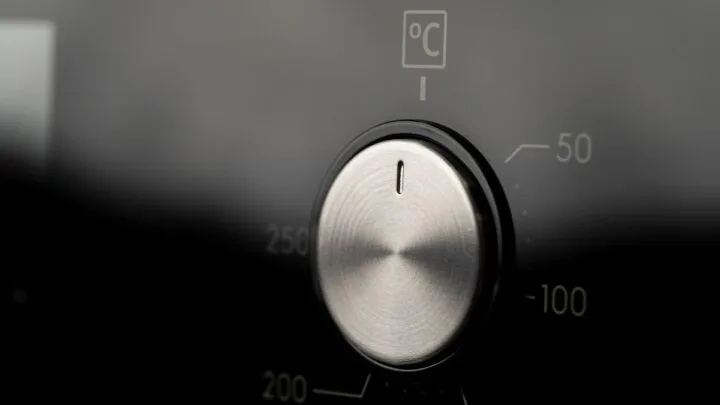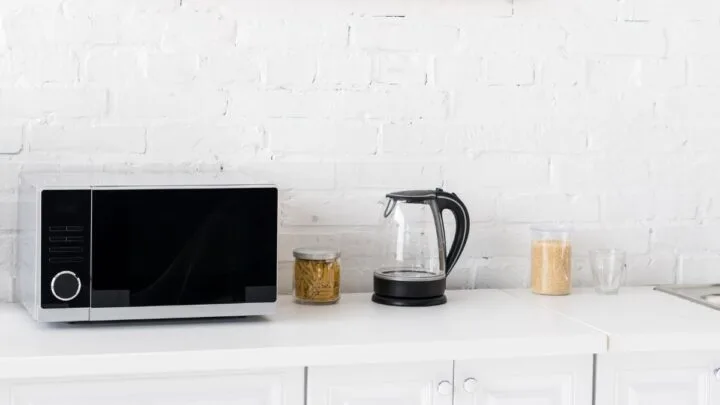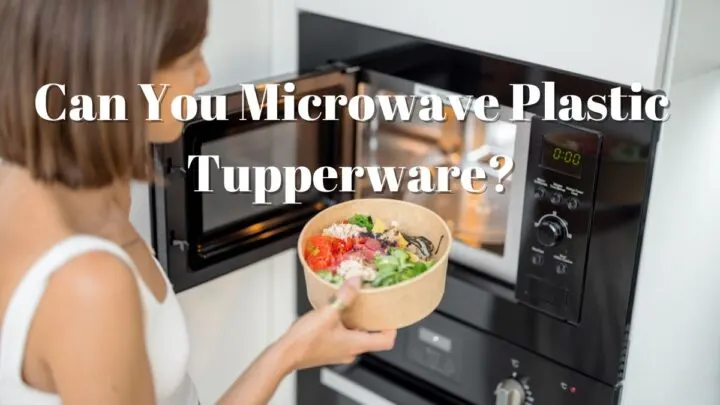Have you heard several confusing statements about the safety of plastic food containers?
We have definitely heard several conflicting statements that make little sense. So we did some digging.
As long as the Tupperware is labeled as microwave safe, you are able to microwave plastic Tupperware.
However, some plastic food containers may contain BPA and other chemicals that will leak into your food.
If you have poorly made or old Tupperware, you’ll be eating plastic chemicals along with last night’s lasagna.
The microwave safe symbol looks like a microwave with some wavy lines going through it.
Not all food storage containers are microwave safe, so look for the microwave safe symbol.
If you don’t see any microwave safe symbols on your Tupperware or other plastic food containers, place your food on a ceramic plate and pop it into the microwave.
Can You Microwave Plastic Tupperware?
We have all placed plastic Tupperware containers in the microwave to heat our food. Since it is in a container, there is no reason to transfer it onto a plate and create more dishes.
We don’t even check to ensure that the container is safe because we have microwaved food in plastic containers all our lives.
But it is important we know about plastics and the effects a microwave’s heat and energy can have on these containers.
So can we microwave plastic tupperware?
Yes, we can microwave tupperware as long as the containers are labeled as microwave safe. But this is a simple answer. The complete answer is a bit more complicated.
Determining Tupperware and Plastic Container Safety
To elaborate, let’s discuss the three factors that determine microwave safety.
- The first factor is heat retained by tupperware containers.
- The second factor is the melting point of the plastic.
- The third factor is the safety of the chemicals in the plastic.
Heat
For heat, you can put the Tupperware container and lid in the microwave and it will not melt or break down.
You should be able to take a cold container of leftovers from the fridge and place it directly in the microwave without the plastic warping.
However, some foods do become scalding hot and will pop and explode. Also, any side of the container the food is touching will be too hot to touch with your bare hand.
Microwave safe Tupperware should only become slightly warm to the touch. But Tupperware should not become hot as if you placed a ceramic plate into the microwave.

Melting in the Microwave
It is not uncommon for Tupperware, and other plastic containers, to become hot in the microwave. But no matter how hot they become, they should not warp or melt inside the microwave.
Even if you heat soup in the microwave, it should not melt the plastic.
This also applies to anything that reaches the boiling point. Plastic food containers and Tupperware should have a melting point of 287°F or 137°C.
However, water boils at 212F. But that does not mean that soup also boils at that temperature.
Some soups are thicker and require more energy and more heat.
There are some cases where soup can reach up to 300° in the microwave. So just be careful when heating thick liquids.
Chemicals in the Plastic
The chemicals in Tupperware will not leach out and contaminate the food.
Why Should You Be Cautious?
Leaching happens when the chemicals in the plastic container leak and contaminate the food. Melting happens when plastic is warmed, like in the microwave.
One of the most concerning chemicals in Tupperware and other types of plastic food containers is BPA.
So when it comes down to it, you need to avoid all food containers that have BPA.
Any food container that does not have a BPA in it will plainly state that it does not have BPA. The BPA-free statement will be somewhere on the box the Tupperware came in or on the container itself.
What is BPA and Why Is It Bad?
You probably heard about the chemical BPA although you don’t know what it is. There have been many warning signs about BPA laced containers in supermarkets for a long time.
In a nutshell, BPA stands for Bisphenol A. BPA is a cancer-causing chemical in most food plastics and some non-food grade plastics. It is also found in safety equipment, toys, and auto parts.
Studies have found that BPA is linked to brain and prostate issues. There could also be a link between BPA and type 2 diabetes, along with cardiovascular disease. Those who are most at risk from BPA or children. This is according to the CDC.
The highest levels of BPA have been found in children. BPA is bad for children because it can harm their brain development. It may even harm the development of a fetus.
Why Was BPA Allowed in the First Place?
Why in the world did the FDA allow BPA to be in our food containers if there is a high correlation between this chemical and harmful side effects?
Most likely, the FDA did not know about the harmful effects of BPA. BPA was developed in the 1960s and its name purpose was to create clear resilient plastic food storage containers..
My Tupperware Is Over a Decade Old. What Should I Do?
If you have Tupperware that is over 10 years old, do not use them in the microwave anymore.
If you don’t want them anymore, then get rid of the Tupperware by throwing them in the recycling bin.
When you purchase new tupperware, make sure the labels clearly state that it is BP free and microwave safe.
If you don’t want to get rid of your old tupperware, then only use those containers to store cold food in the fridge. But don’t put them in the microwave anymore and don’t store hot food in them.

Conclusion to Using Plastic Tupperware in the Microwave
Yes, you should be able to microwave plastic Tupperware and other types of plastic containers.
However, always ensure that you purchase Tupperware and plastic containers that are specifically labeled as BPA free.
Also, check all the plastic food items that come in contact with your child’s food. Pregnant women should beware of the effects of BPA and its effects on the fetus in their rooms.
If you own Tupperware that melts or warps in the microwave, throw it away and purchase new microwave safe BPA free containers.
Just because plastic food containers can store food in the fridge does not always mean that containers are safe for the microwave.


